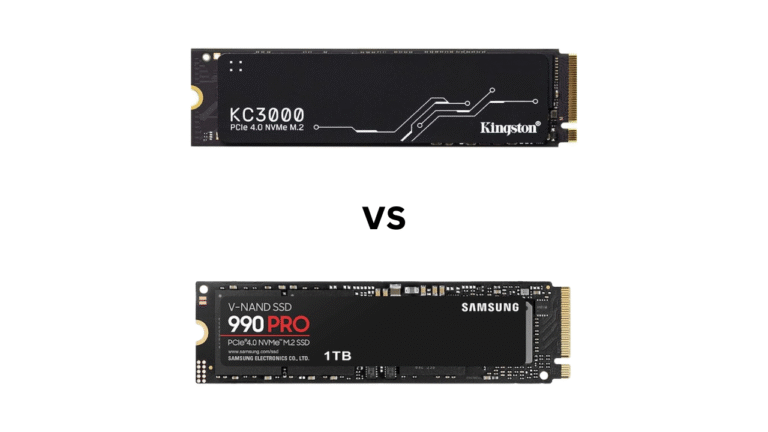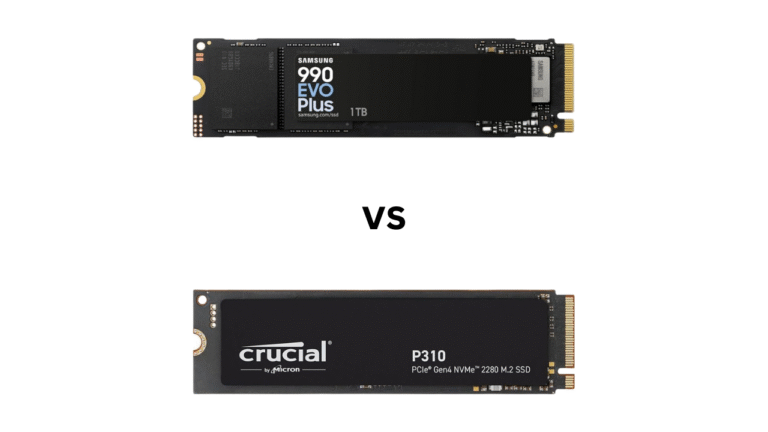Affiliate Disclosure: This post may include affiliate links. If you click and make a purchase, I may earn a small commission at no extra cost to you.
Both the Samsung 9100 Pro and 990 Pro are Samsung’s flagship SSDs. The 9100 Pro is the absolute flagship with great performance and reliability in the Gen 5.0 category. The 990 Pro is the smart flagship that dominates the Gen 4.0 NVMe category. So, performance-wise, there is no competition: the 9100 will win any benchmark. But a comparison would still be interesting.
The 9100 Pro comes with Samsung’s latest Presto controller. Samsung has promised a 49% increase in power efficiency with this newest controller over the 990 Pro. The 990 Pro, on the other hand, is equipped with a slightly older Pascal controller. The 9100 Pro comes in 8TB capacity, as well as the obvious 1TB, 2TB, and 4TB versions. The latest 9100 Pro is being branded as a drive for AI computing, gaming, and heavy-duty workstations, while the 990 Pro is suitable for gamers, creative people, and other general usage.
The 990 Pro is a good pick for those who aren’t enthusiasts or don’t have systems that can utilize Gen 5.0 SSDs. However, for most users, the 990 Pro’s performance is more than enough. We can’t just say the 990 Pro is weak because we are comparing it with the Gen 5.0 SSD. It is one of the best SSDs in its own league.

The NAND flash is the same in both, i.e., Samsung’s TLC V8 V-NAND. The TBW numbers remain the same: 600 TB for 1 TB, 1200 TB for 2 TB, and so on. The 9100 Pro uses a much faster DRAM cache, i.e., LPDDR4X-4266, while the 990 Pro uses LPDDR4-1866. The TurboWrite Cache size is the same on both drives, which we discuss later in the article. Both the SSDs have their heatsink variants which might be necessary if you are planning to put your SSDs under heavy load.
The key differentiators between the two are performance, thermal efficiency, and power consumption, which we will compare and contrast. So, let’s get started.
Samsung 9100 Pro vs 990 Pro Specs
| Specification | Samsung 9100 Pro | Samsung 990 Pro |
|---|---|---|
| PCIe Generation/NVMe Version | PCIe Gen 5.0 x4/ NVMe 2.0 | PCIe Gen 4.0 x4/ NVMe 2.0 |
| Release Date | Feb 25th, 2025 | 2023 |
| Capacities | 1TB, 2TB, 4TB, 8TB | 1TB, 2TB, 4TB |
| Sequential Read Speed | 1TB: 14,700 MB/s 2TB: 14,700 MB/s 4TB: 14,800 MB/s 8TB: 14,800 MB/s | 1TB: 7,150 MB/s 2TB: 7,250 MB/s 4TB: 7,250 MB/s |
| Sequential Write Speed | 1TB: 13,900 MB/s 2TB: 13,400 MB/s 4TB: 13,400 MB/s 8TB: 13,400 MB/s | 1TB: 6,300 MB/s 2TB: 6,300 MB/s 4TB: 6,300 MB/s |
| Random Read Speed | 1TB: 1,850K IOPS 2TB: 1,850K IOPS 4TB: 2,200K IOPS 8TB: 2,200K IOPS | 1TB: 850K IOPS 2TB: 1,350K IOPS 4TB: 1,050K IOPS |
| Random Write Speed | 1TB: 2,600K IOPS 2TB: 2,600K IOPS 4TB: 2,600K IOPS 8TB: 2,600K IOPS | 1TB: 1,350K IOPS 2TB: 1,350K IOPS 4TB: 1,400K IOPS |
| NAND Flash | Samsung V8 V-NAND (TLC) | Samsung V8 V-NAND (TLC) |
| DRAM | Yes | Yes |
| Controller | Samsung Presto | Samsung Pascal |
| Pricing | Starting at $135.66 (1TB) | Starting at $89.99 (1TB) |
The 9100 Pro offers higher performance and a higher-capacity variant (8TB), as we discussed earlier. However, the pricing is where most people would have issues. The 9100 Pro is priced even higher than the existing Gen 5.0 drives, including the Crucial T705 and MP700 Pro. However, for brands like Samsung, people tend to spend more, and perhaps the same holds true for the 9100 Pro.
Benchmark Scores
The benchmark scores are for the 2TB variants of both drives.
PCMark 10 Storage Benchmark
PCMark 10 is one of the most popular trace-based SSD benchmarking software. It takes our drives through the real-world work environment to test their capabilities. You can choose to run a Quick or Full drive benchmark; the Full benchmark provides detailed results from prolonged tests of the OS drives. An overall score will appear along with the bandwidth and latency. Let’s compare the results of both.

The Samsung 9100 Pro absolutely dominates this round. It gets a PCMark 10 score of 6,597 vs 4,651, which is roughly a 42% higher overall performance. The same goes for bandwidth, hitting 1,037 MB/s —about 39% faster than the 990 Pro’s 743 MB/s. And despite that raw power, it still posts a lower latency of 25 µs compared to 36 µs —around a 30% reduction —meaning quicker responsiveness under load. Overall, the 9100 Pro is the better pick for demanding workloads and content creation, while the 990 Pro is fine for everyday use where power efficiency and lower heat are more important.
3DMark Storage Test for Gamers
The 3DMark Storage test evaluates our drives through several gaming-related tests, including loading, saving, streaming, and quitting games. A higher 3DMark score indicates improved gaming performance.
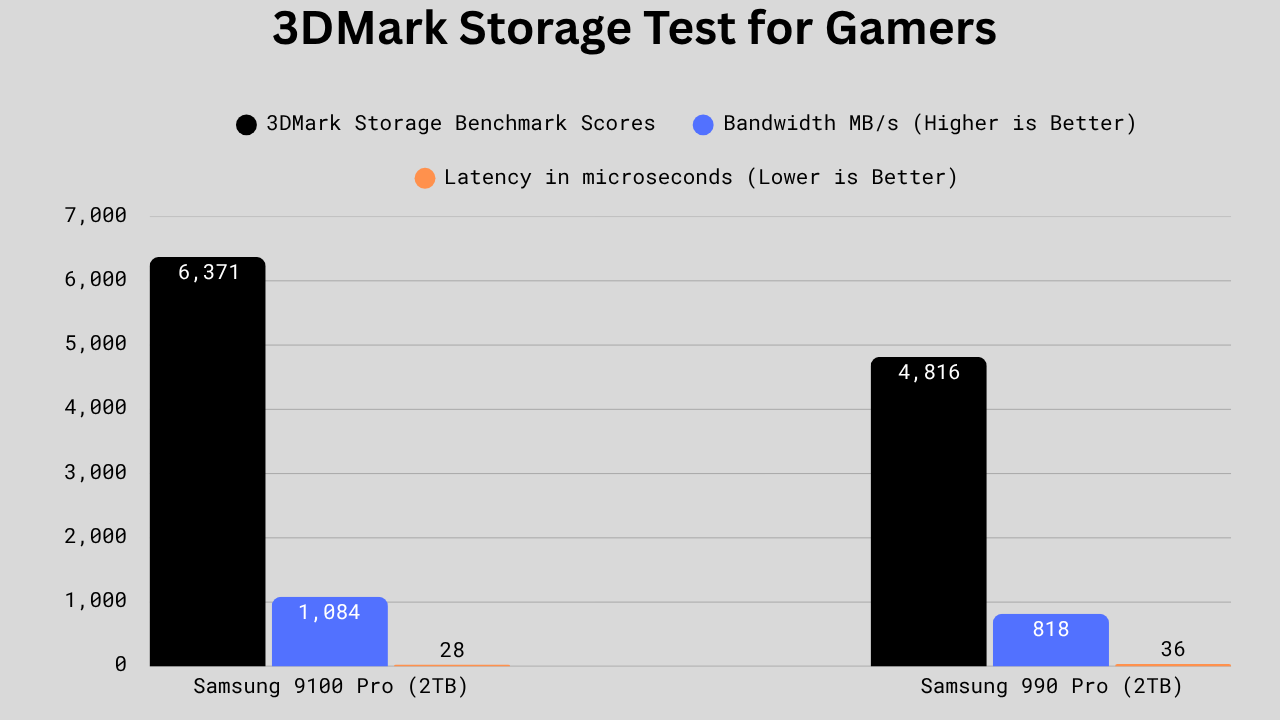
In the 3DMark Storage Benchmark, the Samsung 9100 Pro again takes the lead with a score of 6,371, compared to the 990 Pro’s 4,816, which is about 32% higher. Its bandwidth is higher too, reaching 1,084 MB/s versus 818 MB/s, a gain of roughly 33%. Latency also favors the 9100 Pro at 28 µs compared to 36 µs. Overall, the 9100 Pro is the better drive for gaming or heavy storage tasks that push sustained performance, while the 990 Pro remains a solid pick for everyday computing and balanced workloads.
CrystalDiskMark Peak Read/Write Score (Sequential)
With a 1MB block size, we used queue depths of 1 and 8 for testing sequential peak performance.
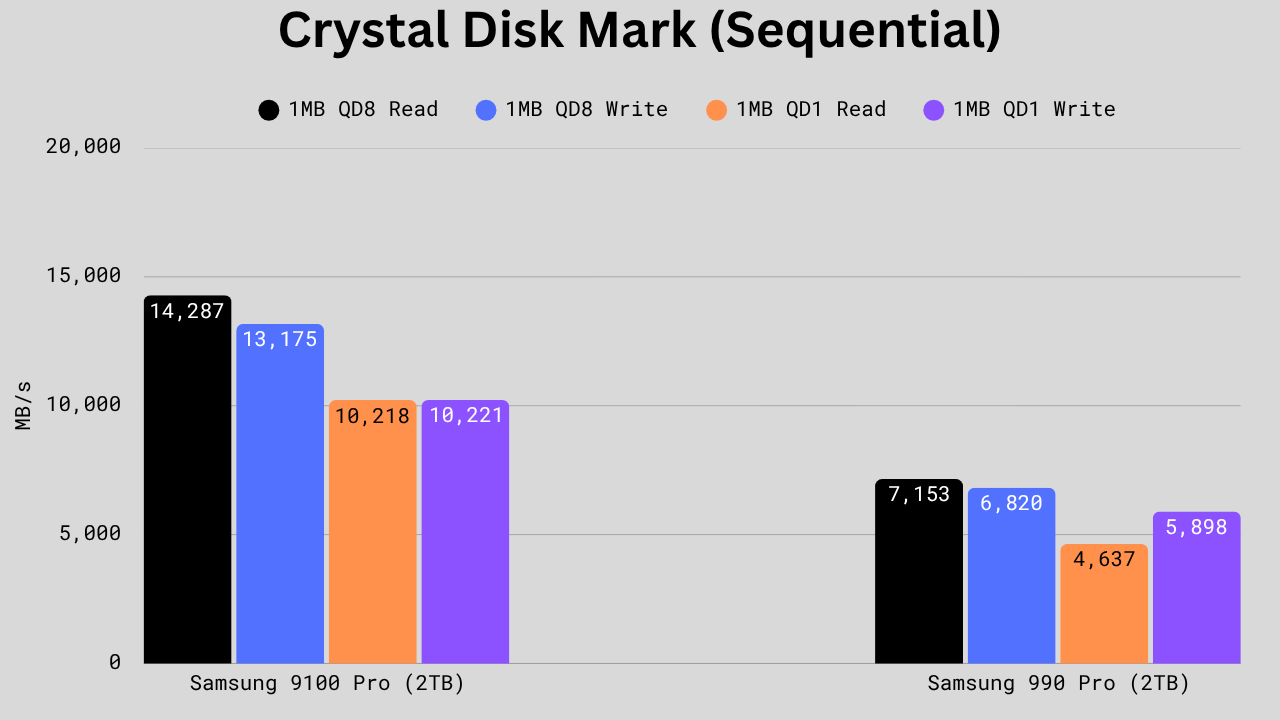
In CrystalDiskMark sequential tests, the Samsung 9100 Pro leaves the 990 Pro in the dust. Its QD8 read speed hits 14,287 MB/s, exactly double the 990 Pro’s 7,153 MB/s, while QD8 writes are also about 93% faster at 13,175 MB/s vs 6,820 MB/s. Even at lower queue depths, the 9100 Pro keeps its edge. QD1 reads and writes are roughly 120% and 73%. The difference isn’t subtle; the 9100 Pro is on another level for raw sequential performance. It’s the clear choice for workloads that utilize large, continuous data streams like 4K video editing or heavy file transfers, while the 990 Pro is still fine for regular desktop or gaming use.
CrystalDiskMark Peak Read/Write Score (Random)
For the peak random read/write benchmarks, the 4KB data blocks were used at the queue depths of 1 and 256, respectively.
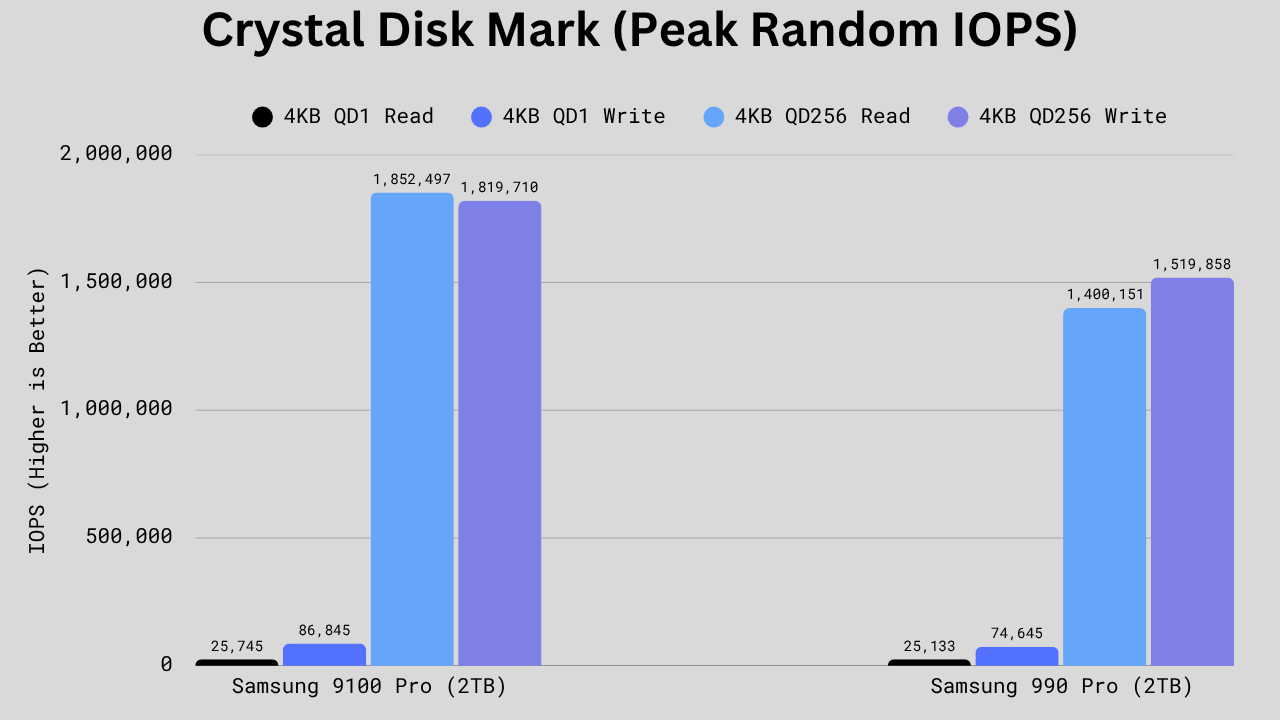
In 4KB random performance, the Samsung 9100 Pro stays ahead, but not by as wide a margin as in sequential tests. At QD1, its read speed is only about 2% faster (25,745 vs 25,133), but its write speed jumps by roughly 16% (86,845 vs 74,645). Things get more dramatic at QD256, where the 9100 Pro pushes about 32% faster reads (1,852,497 vs 1,400,151) and around 20% quicker writes (1,819,710 vs 1,519,858). In short, the 9100 Pro is ideal for enterprise or workstation scenarios with high queue depths, while the 990 Pro is more than capable for lighter desktop or gaming use.
Real-World Transfer Rate Benchmark

In real-world transfer tests, the Samsung 9100 Pro once again comes out on top. It copies a 50GB file at 2,582 MB/s, about 42% faster than the 990 Pro’s 1,821 MB/s. Reading a 6.5GB zip file, it’s also ahead by roughly 22% (4,887 vs 4,014 MB/s). Even in write performance, the 9100 Pro keeps its lead with 2,294 MB/s vs 1,905 MB/s, a gain of around 20%. For anyone doing frequent large file transfers or handling media production tasks, the 9100 Pro is the clear winner, while the 990 Pro is still fine for everyday use or gaming where massive transfers aren’t common.
Power Consumption and Thermals

When it comes to efficiency, the Samsung 990 Pro finally has some ground to stand on. The 9100 Pro delivers a bit more performance per watt at 503 MB/s per watt vs 467, but it does so at the cost of a higher power draw: 5W average vs 4W. It also has a much higher idle consumption (1,924 mW vs 1,252 mW). Its max power draw of 8W also overshadows the 990 Pro’s 6W, resulting in higher temperatures and lower overall efficiency. So while the 9100 Pro wins on sheer performance, the 990 Pro is the smarter, more superb, and more efficient choice for laptops or energy-conscious setups.
The 9100 Pro may use more energy, but it will get your work done faster. Also, the controller is much more optimized than the 990 Pros. According to Tom’s Hardware, it reached 67°C during their tests. With a good heatsink or even without one, this SSD can handle the heat pretty effectively.
TBW, DWPD, MTBF, and Warranty
| Specification | Samsung 9100 PRO | Samsung 990 PRO |
|---|---|---|
| Total Bytes Written (TBW) | – 1TB: 600 TB – 2TB: 1,200 TB – 4TB: 2,400 TB – 8TB: 4,800 TB | – 1TB: 600 TB – 2TB: 1,200 TB – 4TB: 2,400 TB |
| Mean Time Between Failures (MTBF) | Not specified | 1.5 million hours |
| Drive Writes Per Day (DWPD) | 0.3 | 0.3 |
| Warranty | 5-year limited warranty | 5-year limited warranty |
On the endurance and reliability front, both SSDs are identical. Both have the same TBW and DWPD numbers. Also, both come with a 5-year limited warranty. The MTBF for the 9100 Pro isn’t advertised by the brand. So, there is nothing to compare here.
Technical Specifications and Components
| Specification | Samsung 9100 Pro | Samsung 990 Pro |
|---|---|---|
| Controller | Samsung Presto (S4LY027) | Samsung”s Pascal (S4LV008) |
| Controller Architecture | ARM 32-bit Cortex-R8 | ARM 32-bit Cortex-R8 |
| DRAM Specifications | Micron’s LPDDR4X-4266 DRAM 1TB: 1×1024 MB 2TB: 1×2048 MB 4TB: 1x 4096 MB 8TB: 1x 8192 MB | Samsung’s LPDDR4 DRAM 1TB: 1×1024 MB 2TB: 1×2048 MB 4TB: 1x 4096 MB |
| SLC Write Cache | 1TB: approx. 110 GB (dynamic only) 2TB: approx. 220 GB (dynamic only) 4TB: approx. 440 GB (dynamic only) 8TB: – | 1TB: approx. 114 GB (108 GB Dynamic + 6 GB Static) 2TB: approx. 226 GB (216 GB Dynamic + 10 GB Static) 4TB: approx. 442 GB (432 GB Dynamic + 10 GB Static) |
| NAND Flash | Samsung’s V8 V-NAND | Samsung’s V8 V-NAND |
| Topology | 236-Layers | 236-Layers |
| NAND speed | 2400 MT/s | 2400 MT/s |
| Read Time (tR)/Program Time (tProg) | 40 µs/390 µs | 40 µs/390 µs |
| Die Read Speed | 1600 MB/s | 1600 MB/s |
| Die Write Speed | 164 MB/s | 164 MB/s |
| Encryption | AES-256, TCG Opal | AES-256, TCG Opal |
| Power Loss Protection | No | No |
| SMART/TRIM/PS5 Support | Yes/Yes/Yes | Yes/Yes/Yes |
| More Information | Check Datasheet | Check Datasheet |
The Samsung 9100 Pro and 990 Pro share a lot of DNA under the hood, but they’re clearly tuned for different markets, as we saw in the benchmark comparisons above. Both use Samsung’s 236-layer V8 V-NAND, ARM Cortex-R8 controllers, and 2400 MT/s NAND speeds, so raw flash performance isn’t what sets them apart.
The 9100 Pro runs on the Presto (S4LY027) controller paired with Micron LPDDR4X DRAM, while the 990 Pro uses Samsung’s Pascal (S4LV008) and in-house LPDDR4. The number of channels in both controllers is the same, i.e., 8. But the 990 Pro’s Pascal controller is based on the 8nm process and less efficient than Presto’s, which is based on a 5nm process.
The 990 Pro has a slightly more refined SLC cache setup, mixing dynamic and static regions (e.g., 216 GB dynamic + 10 GB static on the 2TB), while the 9100 Pro relies purely on dynamic caching.
Price Difference
By the time I write this article, the 9100 Pro 1TB variant (non-heatsink) is available for $135.66, while the 1TB 990 Pro costs $109.99. The 2TB version of the 9100 Pro is for 216.14$, while the 990 Pro 2TB is available for 173.99$. The 4TB 9100 Pro is priced at 398.35$, while you can get the 4TB 990 Pro for 319$.
Please note that the prices keep changing, but you get my point. The massive performance difference that you see with the 9100 Pro comes with a big price tag as well. However, I would advise you to check the latest prices before you make the purchase.


Which one to choose: Samsung 9100 Pro or Samsung 990 Pro?
The Samsung 9100 Pro is clearly focused on high-end users, gamers, and enthusiasts who want the best storage speed. It comes at a huge price tag, which doesn’t compete directly with the 990 Pro. 9100 Pro’s competitors are Crucial T700, Corsair MP700 Pro, MP 700 Pro SE, Sabrent Rocket 5, Firecuda 540, etc. Here, in terms of performance, the Samsung 9100 Pro is the winner. If you can afford it and you have a Gen 5.0 system that can utilize it properly, you should have it.
However, the Samsung 990 Pro is still more than enough for most common users, content creators, gamers, etc. For most real-world tasks, you will hardly be able to tell any difference between these two drives. However, if you’re talking about peak sequential numbers, the 9100 Pro is the clear winner. The 990 Pro does the job perfectly on a smaller budget. So, if you are not a high-end user or an SSD enthusiast, there is no need to spend extra money on the 9100 Pro.
I would like to hear your views in the comments section!

